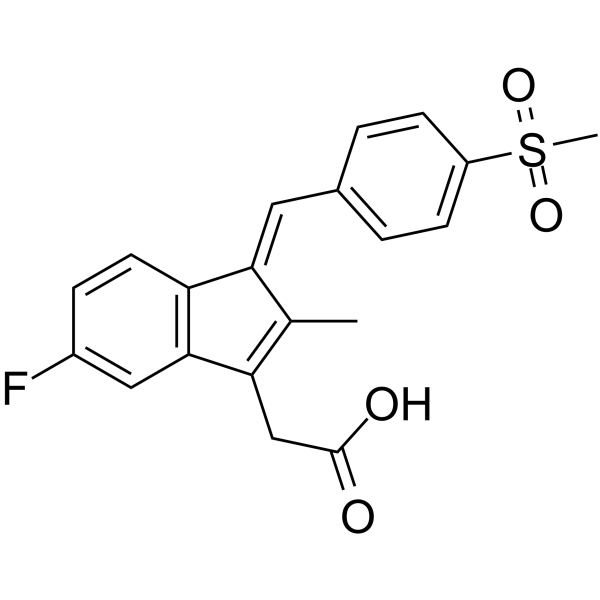Exisulind

Exisulind structure
|
Common Name | Exisulind | ||
|---|---|---|---|---|
| CAS Number | 59864-04-9 | Molecular Weight | 372.41 | |
| Density | 1.4±0.1 g/cm3 | Boiling Point | 601.9±55.0 °C at 760 mmHg | |
| Molecular Formula | C20H17FO4S | Melting Point | N/A | |
| MSDS | USA | Flash Point | 317.8±31.5 °C | |
|
Exisulind: Aptosyn, FGN 1, Prevatac, sulindac sulfone.
Drugs R. D. 5(4) , 220-6, (2004) Exisulind [Aptosyn trade mark, FGN 1 trade mark, Prevatac trade mark, sulindac sulfone], the sulfone derivative of sulindac, is the lead compound in a series of selective apoptotic antineoplastic drugs (SAANDs) being developed by OSI Pharmaceuticals. The comp... |
|
|
Sulindac sulfide, but not sulindac sulfone, inhibits colorectal cancer growth.
Neoplasia 1(2) , 170-6, (1999) Sulindac sulfide, a metabolite of the nonsteroidal antiinflammatory drug (NSAID) sulindac sulfoxide, is effective at reducing tumor burden in both familial adenomatous polyposis patients and in animals with colorectal cancer. Another sulindac sulfoxide metabo... |
|
|
Sulindac sulfone inhibits K-ras-dependent cyclooxygenase-2 expression in human colon cancer cells.
Cancer Res. 60(23) , 6607-10, (2000) Both the sulfide and sulfone metabolites of sulindac, a nonsteroidal anti-inflammatory drug, display anticarcinogenic effects in experimental models. Sulindac sulfide inhibits cyclooxygenase (COX) enzyme activities and has been reported to suppress ras-depend... |
|
|
Antiangiogenic effect of sulindac sulfide could be secondary to induction of apoptosis and cell cycle arrest.
Anticancer Res. 26(4B) , 3033-41, (2006) The development of colon cancer is probably angiogenesis-dependent. Recently, sulindac sulfide was shown to possess anti-angiogenic activity. In the present work, the question of whether this activity reflects a specific interaction with angiogenesis or is se... |
|
|
Optimisation and validation of a fast HPLC method for the quantification of sulindac and its related impurities.
J. Pharm. Biomed. Anal. 54(4) , 694-700, (2011) The European Pharmacopoeia describes a liquid chromatography (LC) method for the quantification of sulindac, using a quaternary mobile phase including chloroform and with a rather long run time. In the present study, a new method using a short sub-2 μm column... |
|
|
The molecular basis for inhibition of sulindac and its metabolites towards human aldose reductase.
FEBS Lett. 586(1) , 55-9, (2012) Sulindac (SLD) exhibits both the highest inhibitory activity towards human aldose reductase (AR) among popular non-steroidal anti-inflammatory drugs and clear beneficial clinical effects on Type 2 diabetes. However, the molecular basis for these properties is... |
|
|
Sulindac sulfide reverses aberrant self-renewal of progenitor cells induced by the AML-associated fusion proteins PML/RARα and PLZF/RARα.
PLoS ONE 6(7) , e22540, (2011) Chromosomal translocations can lead to the formation of chimeric genes encoding fusion proteins such as PML/RARα, PLZF/RARα, and AML-1/ETO, which are able to induce and maintain acute myeloid leukemia (AML). One key mechanism in leukemogenesis is increased se... |
|
|
Effect of sulindac sulfide on metallohydrolases in the human colon cancer cell line HT-29.
PLoS ONE 6 , e25725, (2011) Matrix metalloproteinase 7 (MMP7), a metallohydrolase involved in the development of several cancers, is downregulated in the Apc(Min/+) colon cancer mouse model following sulindac treatment. To determine whether this effect is relevant to the human condition... |
|
|
Sulindac and its metabolites: sulindac sulfide and sulindac sulfone enhance cytotoxic effects of arsenic trioxide on leukemic cell lines.
Toxicol. In Vitro 25(5) , 1075-84, (2011) The effects of arsenic trioxide (ATO) in combination with sulindac (SUL), sulindac sulfide (SS) or sulindac sulfone (SF) on human (Jurkat, HL-60, K562 and HPB-ALL) and mouse (EL-4) leukemic cell lines were investigated. The cells showed different sensitivity ... |
|
|
Assessment of the involvement of oxidative stress and Mitogen-Activated Protein Kinase signaling pathways in the cytotoxic effects of arsenic trioxide and its combination with sulindac or its metabolites: sulindac sulfide and sulindac sulfone on human leukemic cell lines.
Med. Oncol. 29(2) , 1161-72, (2012) The purpose of the study was to characterize the involvement of reactive oxygen species (ROS) in mediating the cytotoxic effects of arsenic trioxide (ATO) in combination with sulindac or its metabolites: sulfide (SS) and sulfone (SF) on human leukemic cell li... |